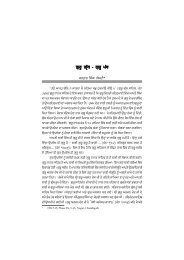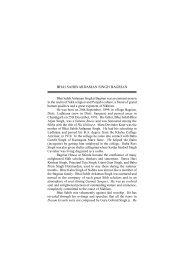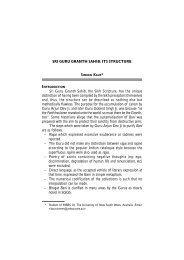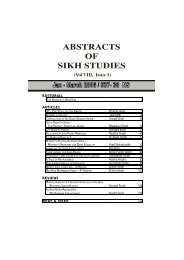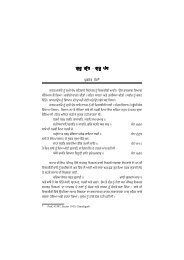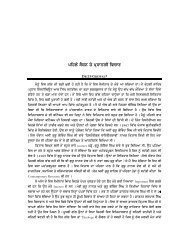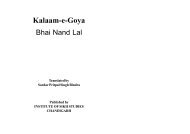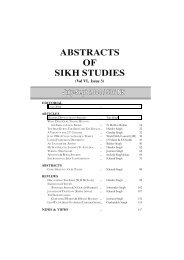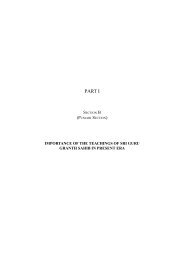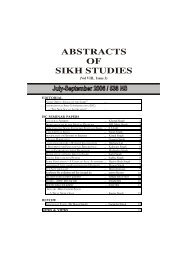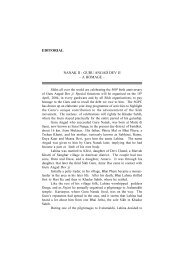editorial articles reviews news & views - Institute of Sikh Studies
editorial articles reviews news & views - Institute of Sikh Studies
editorial articles reviews news & views - Institute of Sikh Studies
Create successful ePaper yourself
Turn your PDF publications into a flip-book with our unique Google optimized e-Paper software.
MCLEOD & FENECH AS SCHOLARS ON SIKHISM AND MARTYRDOM<br />
85<br />
Kashmir”. Then follows the author’s description <strong>of</strong> it as “a powerful<br />
myth”, one firmly lodged by Tat Khalsa discourse. This, according to<br />
him is not borne out by earlier written evidence. Then he quotes “Guru<br />
Gobind Singh’s peroration that Guru Tegh Bahadur died for protection<br />
<strong>of</strong> sacred thread and frontal mark <strong>of</strong> theirs i.e., the Hindus; he reflects<br />
his intellectual dishonesty by disputing as if the “sacred thread and<br />
frontal mark, were not recognised as religious emblems by the <strong>Sikh</strong>s<br />
‘as by the Hindus”. He goes on to say that even this understanding <strong>of</strong><br />
Guru Gobind Singh could only be attributed to Khalsa. He quotes<br />
Oberoi about Sanatan <strong>Sikh</strong>s, a product <strong>of</strong> 19th century, who could be<br />
as comfortable in Haridwar or Amritsar. He also brings in Brahminical<br />
infiltrators <strong>of</strong> 18th century to say unfaithfully that Guru Gobind<br />
sacrified 125,000 <strong>Sikh</strong>s to the goddess. He even brings in the support<br />
<strong>of</strong> Nirmala <strong>Sikh</strong> Scholar, Bhai Santokh Singh. The point is that he<br />
brings in all sorts <strong>of</strong> hostile writings which should have been rejected<br />
without a second thought. Fenech concedes that Guru Tegh Bahadur<br />
died as a martyr that he died for his own community. He does not<br />
mention that even Hindus don’t dispute Guru Tegh Bahadur’s<br />
maryradom for their cause.<br />
The author now brings in one Ghazi Mian whose head was severed<br />
from his body, a man <strong>of</strong> karamat or miraculous power. His shrine was<br />
revered both by Hindus and Muslims. There was also one Baba Chuda, a<br />
Bhandari Khatri, who too was a headless martyr at Batala, during Nadir<br />
Shah’s invasions. He makes mention <strong>of</strong> numerous others. Some were<br />
malevolent, others not. He would like to indicate that “the status <strong>of</strong> martyr<br />
was awarded to far more people than our <strong>Sikh</strong> sources indicate.” Some <strong>of</strong><br />
them did appear as the malevalent ghosts “known in Punjabi folk called<br />
birs (heroes), bhuts, prets and churels”. He wants to suggest that “Indian<br />
martyrs were indeed both figures <strong>of</strong> universal powers and a variety <strong>of</strong><br />
malevolent ghosts”. He also brings in Sau Sakhian.<br />
The whole objective <strong>of</strong> his exercise becomes clear when he<br />
mention <strong>of</strong> Baba Dip Singh, and prayer to him to “grant the wishes <strong>of</strong><br />
all those who propitiate him.” Propitiating a bir (hero) is one thing, a<br />
bhut quite another. How could the <strong>Sikh</strong>s ask Guru Gobind Singh about<br />
the sacrifice, a <strong>Sikh</strong> makes half a century later Fenech is not interested



